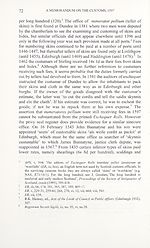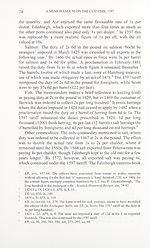Series 5 > Miscellany [of the Scottish History Society] XIII
(88) Page 73
Download files
Complete book:
Individual page:
Thumbnail gallery: Grid view | List view

MISCELLANY XIII
73
footfells (3s 4d) and lentrenware (Is).1 An act of 1424 imposed duties
on skins of wild animals, e.g. marten, polecat, otter, fox, deer and
rabbit. These appear infrequently in the records until the late sixteenth
century.2 None of the duties on skins was changed in 1597.
Hides: Though the 1368 act also made the duty on hides
proportional to that on wool, they were counted in a different manner.
The duty was four merks (53s 4d) for each last, made up of 20 dacres
each containing 10 hides.3 This was unchanged in 1597.
Cloth: Woollen cloth was first made customable in 1425, with an
ad valorem duty of 2s in the pound.4 This required the custumar to
assess both quantity and value, each based on the ‘dozen’, a length of
cloth containing twelve ells (approximately 12 metres). At Stirling in
1462 Matthew Forester refused to accept the custumar’s estimate and
sent his pack to the ship uncustomed.5 In practice, as the
memorandum shows, a uniform rate was applied to cloth of ‘various
prices’. Haddington’s customs book for 1504 shows total cloth
exports of 127 dozen valued at 24s, paying £15 4s 9d or
approximately 2s 5d per dozen.6 The memorandum refers to the
account for Stirling in 1512 where the value is given as only 20d per
ell (£1 per dozen) and duty paid on 65 dozen as £5 8s 4d, or Is 8d per
dozen.7 In fact, the old system had already started to break down. In
1502 the custumars of Ayr and Cupar had to be ordered to levy
according to the true value as required by the act, but in the following
year the custumars of Edinburgh accounted for only £211 5 s for the
custom of 4,225 dozen, or Is per dozen.8 In 1516 the auditors of
exchequer ordered custumars to levy a new rate of 2s 6d on each
dozen of broad cloth whether dyed or undyed.9 This was only partially
effective. By 1542 Aberdeen, Dundee, Linlithgow, and some smaller
ports were paying 2s 6d. But while Stirling collected £30 for 240
dozen (2s 6d), Irvine collected only £26 3 s for 523, more than double
1 ER, iv, cxxix, 604. Shorlings were skins of shorn sheep, scaldings skins of small
value, footfells and lentrenware skins of lambs that had died soon after birth
{Oxford English Dictionary).
2 1424 c 23; APS, ii, 6; ER, iv, cxxvi; E71/30/28. They are listed under skins in
E76/1/1.
3 APS, i, 504; ER, ix, p. Ixx.
4 1424/5 c \9,APS, ii, 8.
5 ER, vii, 219.
6 E71/16/1. The total in the book is ‘cvii’, i.e. one long hundred and seven (127).
7 cf ER, xiii, 479.
8 ER, xii, 79, 84, 162 (long hundreds converted to normal hundreds).
9 ER, xiv 564; for date see CS5/28, fo.25, 25 Aug. 1516.
73
footfells (3s 4d) and lentrenware (Is).1 An act of 1424 imposed duties
on skins of wild animals, e.g. marten, polecat, otter, fox, deer and
rabbit. These appear infrequently in the records until the late sixteenth
century.2 None of the duties on skins was changed in 1597.
Hides: Though the 1368 act also made the duty on hides
proportional to that on wool, they were counted in a different manner.
The duty was four merks (53s 4d) for each last, made up of 20 dacres
each containing 10 hides.3 This was unchanged in 1597.
Cloth: Woollen cloth was first made customable in 1425, with an
ad valorem duty of 2s in the pound.4 This required the custumar to
assess both quantity and value, each based on the ‘dozen’, a length of
cloth containing twelve ells (approximately 12 metres). At Stirling in
1462 Matthew Forester refused to accept the custumar’s estimate and
sent his pack to the ship uncustomed.5 In practice, as the
memorandum shows, a uniform rate was applied to cloth of ‘various
prices’. Haddington’s customs book for 1504 shows total cloth
exports of 127 dozen valued at 24s, paying £15 4s 9d or
approximately 2s 5d per dozen.6 The memorandum refers to the
account for Stirling in 1512 where the value is given as only 20d per
ell (£1 per dozen) and duty paid on 65 dozen as £5 8s 4d, or Is 8d per
dozen.7 In fact, the old system had already started to break down. In
1502 the custumars of Ayr and Cupar had to be ordered to levy
according to the true value as required by the act, but in the following
year the custumars of Edinburgh accounted for only £211 5 s for the
custom of 4,225 dozen, or Is per dozen.8 In 1516 the auditors of
exchequer ordered custumars to levy a new rate of 2s 6d on each
dozen of broad cloth whether dyed or undyed.9 This was only partially
effective. By 1542 Aberdeen, Dundee, Linlithgow, and some smaller
ports were paying 2s 6d. But while Stirling collected £30 for 240
dozen (2s 6d), Irvine collected only £26 3 s for 523, more than double
1 ER, iv, cxxix, 604. Shorlings were skins of shorn sheep, scaldings skins of small
value, footfells and lentrenware skins of lambs that had died soon after birth
{Oxford English Dictionary).
2 1424 c 23; APS, ii, 6; ER, iv, cxxvi; E71/30/28. They are listed under skins in
E76/1/1.
3 APS, i, 504; ER, ix, p. Ixx.
4 1424/5 c \9,APS, ii, 8.
5 ER, vii, 219.
6 E71/16/1. The total in the book is ‘cvii’, i.e. one long hundred and seven (127).
7 cf ER, xiii, 479.
8 ER, xii, 79, 84, 162 (long hundreds converted to normal hundreds).
9 ER, xiv 564; for date see CS5/28, fo.25, 25 Aug. 1516.
Set display mode to:
![]() Universal Viewer |
Universal Viewer | ![]() Mirador |
Large image | Transcription
Mirador |
Large image | Transcription
Images and transcriptions on this page, including medium image downloads, may be used under the Creative Commons Attribution 4.0 International Licence unless otherwise stated. ![]()
| Scottish History Society volumes > Series 5 > Miscellany [of the Scottish History Society] XIII > (88) Page 73 |
|---|
| Permanent URL | https://digital.nls.uk/127314585 |
|---|
| Description | Over 180 volumes, published by the Scottish History Society, containing original sources on Scotland's history and people. With a wide range of subjects, the books collectively cover all periods from the 12th to 20th centuries, and reflect changing trends in Scottish history. Sources are accompanied by scholarly interpretation, references and bibliographies. Volumes are usually published annually, and more digitised volumes will be added as they become available. |
|---|


